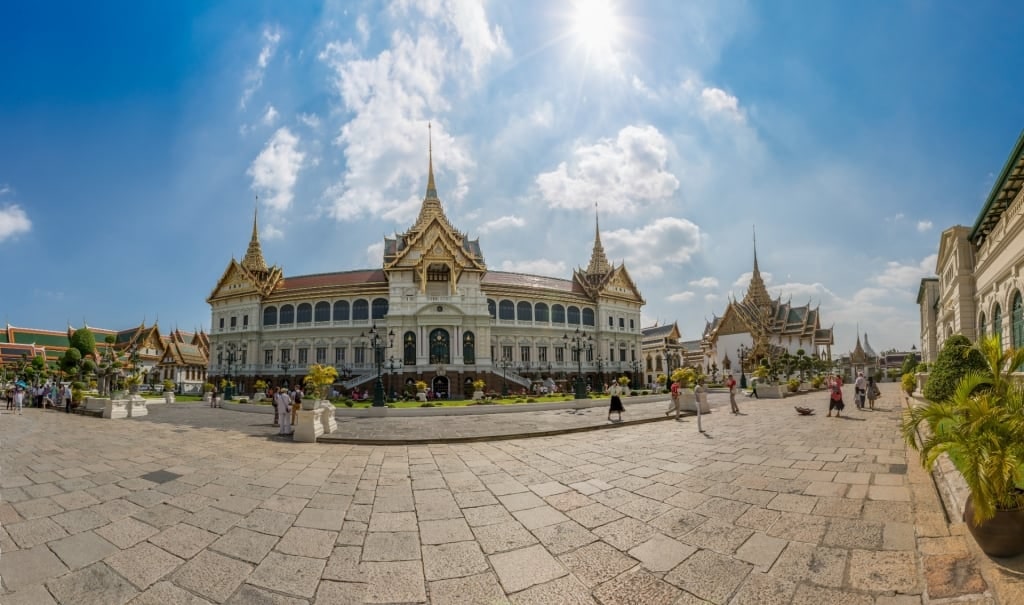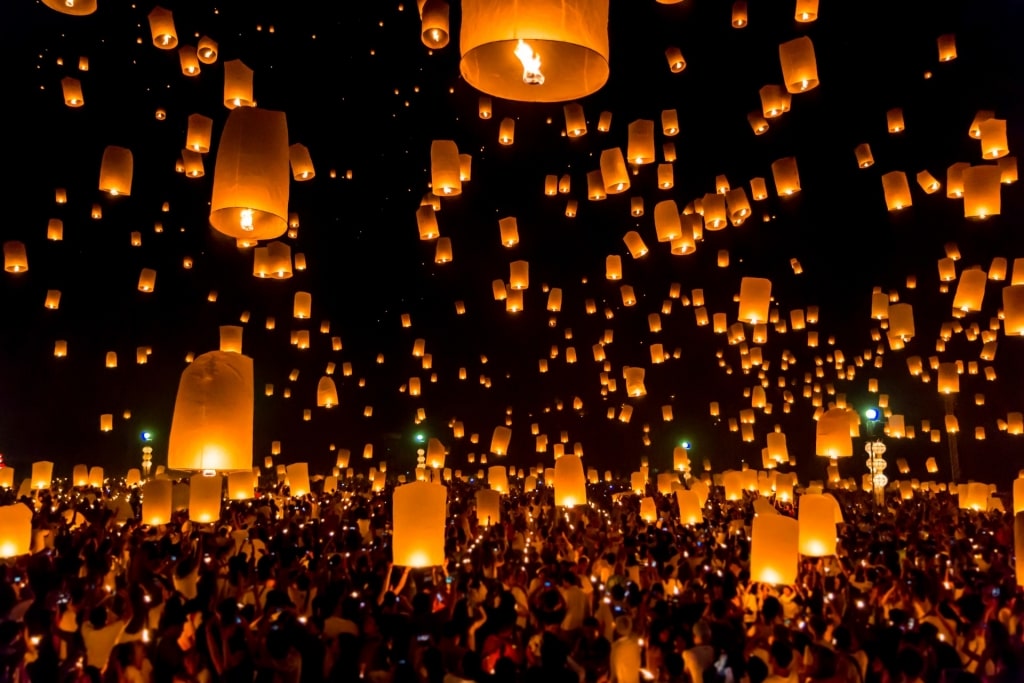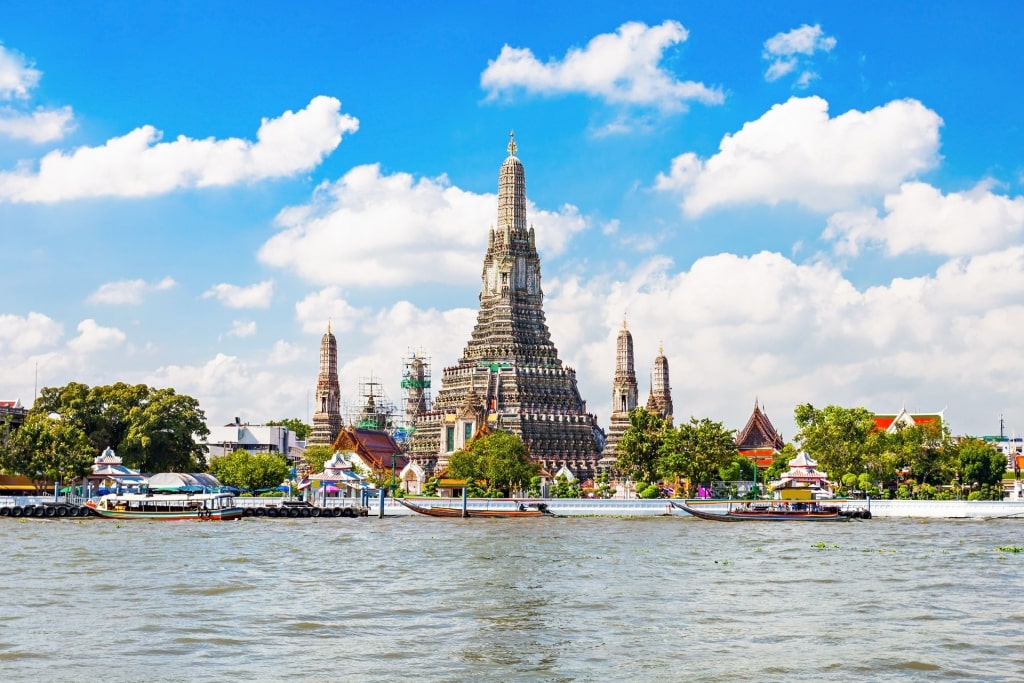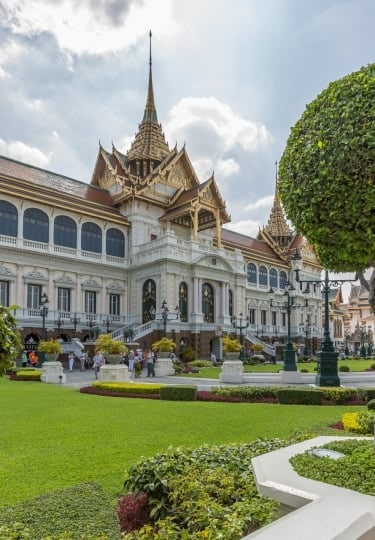As a general rule, the best time to visit Thailand is from November to March, and occasionally during the earlier parts of April (typically the hottest month on the calendar).
This is the high season when the monsoon rains have passed, and you can count on relatively dry weather. That being said, Thailand enjoys a subtropical climate, which means you can visit any time of year, as long as you can cope with variable weather conditions.
The south, including the Malay Peninsula, and the islands in the Gulf of Thailand and the Andaman Sea, are often defined by their “wet” and “dry” seasons, contingent upon where you are related to the peninsula. Northern Thailand tends to experience more differentiated seasons compared to the coastal south.
Visiting Thailand By Season
Summer

Grand Palace, Bangkok
From late April, and heading into summer, things heat up in Thailand. Mother Nature will be more than happy to dump a deluge of rain on your head during this period as well—sometimes for days on end.
Summer temperatures occasionally hike up past 104°F (40°C), and the rain and humidity lean toward the heavier side. Monsoons hit in late June, blanketing most of the country, with average highs in the vicinity of 93°F (34°C).
July continues the wet streak, with highs of around 92°F (33°C). You’ll still feel the humidity in August, although temperatures cool down slightly, with averages of around 84°F (29°C). If you head up into the mountainous areas in the north, expect it to be a few degrees cooler, which can be a welcome relief.
Fall
While autumn might not be the best time to visit Thailand, it’s generally better than summer as far as the heat is concerned.
September still sees lots of rain, which begins to subside in some regions toward the end of October. The north tends to dry out before the southern parts of the country. Average temperatures in October hover around 89° to 91°F (32° to 33°C) on the high end of the spectrum, with lows of around 73° to 74°F (around 23°C).
Come November, the “cooler” season kicks into gear with drier, more manageable weather. November is also when visitors begin flocking to the country to enjoy the beaches, spicy food, and lush, rain-fed natural scenery that Thailand is known for.
Read: What to Eat in Thailand

Ko Phi Phi Leh, near Phuket
Winter
Winter, by most people’s standards, is the best time to go to Thailand. The humidity in many parts of the country reduces by half and the drier weather rolls in. Temperatures, on average, range between 82° to 90° or 91°F (roughly 28° to 33°C).
Higher elevations, up north, will naturally be cooler in winter, with lows occasionally dipping down to freezing levels, although that doesn’t happen often. Overall, winter weather in Thailand—especially near the sea—is exceedingly pleasant.
Spring
Early springtime in Thailand still technically counts as the dry season, although the humidity and temperatures ratchet up, sometimes to oppressive levels. April, as noted, is the hottest month of the year.
Spring temperatures tend to linger in the mid-90s Fahrenheit (around 34°C). Lows are in the upper 80s. You can try for some heat relief during the day by hanging out in the sea, but with water temperatures of around 86°F (30°C), it might not be as much of a relief as you’d like.
When Is Rainy Season?
Thailand’s rainy season kicks off in late June or July, and extends into October, with September and October clocking in as the wettest months (often with rain every day) of the year.
In the south, along the peninsula, and on the islands, you can get more than 100 inches (2,500mm) of annual rain or more. Bangkok gets approximately 60 inches (1,500mm) of precipitation per year. Nationwide, you can expect about 63 inches (1,600 mm) of rain, on average.
When Is High Season?
November through March is Thailand’s high season, with relatively dry weather and agreeable temperatures. This is a great time to enjoy the country’s cultural and natural splendor.
During the high season, you can experience Chinese New Year celebrations in Bangkok’s Chinatown, or ooh and aah at the illuminated beauty of Chiang Mai’s Lantern Festival, held in November along the Ping River.

Lantern Festival, Chiang Mai
When Is Shoulder Season?
Shoulder season in Thailand lands in the April to June period, when the country really heats up. Many people consider September and October as shoulder season, too.
If you do arrive in April, you can enjoy Thailand’s traditional Songkran New Year, which is accompanied by water “fights” on the street. Lots of folks toting colorful squirt guns walk around soaking one another, which is one way to get a break from the heat.
The best time to go to Thailand, relative to shoulder season, is usually during September or October; the weather begins to cool off, and the crowds haven’t arrived yet, although heavy rain can still be an issue.
When Is Low Season?
The low season in Thailand coincides with the monsoon season, from July to October. Floods, rain, high humidity, heat, storms, and reduced transport options (especially to the islands) make travel more difficult.

Wat Arun, Bangkok
If Thailand, with its glorious weather, and even its rainy period, has piqued your interest, browse our cruises to Thailand and book your next voyage to this wonderful southeast Asian country.



